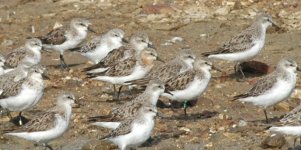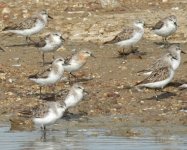Laurie Knight
Well-known member
Migrant waders are arriving in Australia. I photographed a stint with remnants of breeding plumage yesterday in Brisbane. I noted that the colour around its neck and throat superficially resemble the pattern of Little Stints.
I suspect, however, that it is a Red Neck Stint and that RNS go through a moult sequence that produces a white throat before the red chest band disappears. Is that correct?
The stint wearing a green flag is a locally banded bird.
Regards, Laurie.
I suspect, however, that it is a Red Neck Stint and that RNS go through a moult sequence that produces a white throat before the red chest band disappears. Is that correct?
The stint wearing a green flag is a locally banded bird.
Regards, Laurie.





